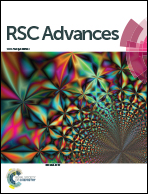Highly thermally conductive polymer nanocomposites based on boron nitride nanosheets decorated with silver nanoparticles†
Abstract
The development of thermally conductive polymer composites is of critical importance to address the issue of heat aggregation in modern electronics with rapid-increasing power density. However, the thermal conductivity (K) of the polymer composites has long been limited to within 10 W m−1 K−1 due to the high interfacial thermal resistance. Herein, we have demonstrated a remarkable improvement in K upon the incorporation of boron nitride nanosheets doped with silver nanoparticles hybrids (BNNSs/AgNPs). The incorporation of BNNSs/AgNPs into liquid crystalline epoxy resin (LCER) yields an in-plane K of 12.55 W m−1 K−1 with 25.1 vol% boron nitride nanosheets (BNNSs). The interfacial thermal resistance among BNNSs has demonstrated to reduce by sintering silver nanoparticles (AgNPs) deposited on the surface of BNNSs, forming more thermally conductive networks with higher K. As a proof of concept application, the obtained composite was used as the substrate for light-emitting-diode chips and was demonstrated to be more effective in heat removal than the bulk LCER. This study establishes an efficient approach to prepare thermally conductive composites, which can be applied in the next generation of integrated circuits and three-dimensional electronics.


 Please wait while we load your content...
Please wait while we load your content...